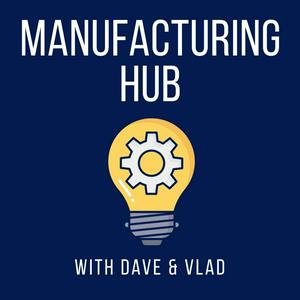Ep. 229 - Manufacturing Architecture Explained Every Engineer and Plant Manager Needs to Know Today
In this episode of Manufacturing Hub, Vlad and Dave take a deep dive into one of the most critical yet often overlooked aspects of modern manufacturing: network and systems architecture. Too often manufacturers focus on SCADA, MES, and control layers without recognizing that the architecture beneath them is the foundation that determines whether a facility can scale, connect new equipment, and maintain reliability. Architecture touches everything from plant floor PLCs and HMIs to edge devices, managed switches, firewalls, historians, and enterprise-level systems.We begin the conversation by unpacking what “architecture” actually means in manufacturing environments. Is it the hardware, switches, and cables? Is it the way new machines are integrated into existing plants? Or is it the broader strategy of ensuring that data, safety, and scalability are protected? The answer, as both Vlad and Dave explain, is that it is all of these at once.Throughout the discussion, we explore real-world stories where poor architectural decisions led to unplanned downtime, cybersecurity risks, or expensive rework. Vlad shares an example of a palletizer brought online with unmanaged switches and insecure remote access hardware that nearly crippled production until it was properly segmented. Dave recalls his own field experiences, including unusual setups where integrators resorted to improvised remote troubleshooting, highlighting just how creative but fragile some solutions can be.The episode also looks at the evolution of remote access. From the early days of Ewon boxes to modern expectations of secure VPNs, jump boxes, and approved engineering workstations, we discuss what role remote connectivity should play in today’s manufacturing environment. While these solutions can reduce travel time and speed up support, they can just as easily introduce vulnerabilities and trust issues if not carefully managed.From there we move into the technical tradeoffs of device level ring versus star topologies. Vlad explains why he often prefers device level ring to save costs and simplify troubleshooting, while Dave weighs in on the importance of pre-molded cables, managed switches, and long-term maintainability. We also analyze example architectures from Rockwell white papers, pointing out where diagrams align with field best practices and where they differ from what engineers often see in real facilities.Finally, we broaden the perspective by comparing greenfield and brownfield deployments. Greenfield projects allow prime contractors and consultants to design standards up front, but most facilities live in brownfield reality where years of technical debt, unmanaged switches, and ad hoc networks make improvements harder. We also touch on how architecture differs by industry, whether in food and beverage, pharmaceuticals, oil and gas, or distributed environments such as trains or pipelines.The conversation closes with predictions, career advice, and resource recommendations. Vlad stresses that CCNA is still one of the best starting points for engineers who want to understand industrial networking fundamentals, and Dave emphasizes the importance of asking the right questions and learning from experienced peers. Both agree that demand for data, combined with the rise of AI, will continue to stress legacy networks until companies recognize the need for robust, standards-driven architectures.If you work in automation, engineering, IT, or plant management, this episode will give you perspective on why network architecture is not just a technical afterthought but a strategic enabler of digital transformation.Timestamps 00:00 Introduction and community updates 02:30 Defining architecture in manufacturing 05:00 Why networks are the backbone of manufacturing systems 08:00 A real-world palletizer story and the risks of unmanaged switches 14:00 The rise and pitfalls of remote access devices 18:30 Field story of unconventional remote troubleshooting setups 23:00 Who is responsible for network design: end users, integrators, or OEMs 28:00 Analyzing Rockwell’s reference architecture diagrams 36:00 Device level ring versus star topologies in practice 49:00 Brownfield versus greenfield considerations 56:00 Industry-specific architectures from food and beverage to oil and gas 01:04:00 The role of standards and corporate versus local decision making 01:08:30 Predictions, career advice, and recommended resourcesReferences Mentioned in this Episode Ignition Community Conference: https://icc.inductiveautomation.com/ Siemens SPS Atlanta Event: https://new.siemens.com/us/en/company/fairs-events/sps.html Rockwell Automation Architectures and Design White Papers: https://literature.rockwellautomation.com CISSP Official Study Guide: https://www.isc2.org/Certifications/CISSP Winning by Tim Grover: https://www.amazon.com/Winning-Unforgiving-Race-Greatness/dp/1982168862 Cisco CCNA Certification: https://www.cisco.com/c/en/us/training-events/training-certifications/exams/current-list/ccna.htmlAbout the HostsVlad Romanov is an electrical engineer and consultant with over a decade of experience in manufacturing and industrial automation. His background spans global companies such as Procter & Gamble, Kraft Heinz, and Post Holdings, where he has led modernization projects, SCADA and MES deployments, and digital transformation initiatives. He is the founder of Joltek, a consulting firm helping manufacturers align people, process, and technology to improve operations, and he also leads SolisPLC, an education platform for automation professionals. Connect with Vlad on LinkedIn: https://www.linkedin.com/in/vladromanovDave Griffith is a manufacturing consultant and co-host of Manufacturing Hub. With extensive experience in controls, systems integration, and business development, Dave has helped manufacturers across industries adopt SCADA, MES, and digital transformation solutions. He frequently shares insights on IT-OT convergence, operational strategy, and leadership in the automation space. Connect with Dave on LinkedIn: https://www.linkedin.com/in/davegriffithJoltek is a consulting and integration firm that helps manufacturers modernize with clarity, strategy, and execution. Built on decades of hands-on experience in engineering, automation, and plant leadership, Joltek bridges the gap between technical complexity and business value. The team is known for uncovering hidden risks in outdated systems, designing scalable IT and OT architectures, and guiding digital transformation initiatives that actually deliver measurable results. Whether it is upgrading control systems, deploying SCADA and MES platforms, or advising on strategic investments, Joltek consistently brings deep expertise and practical solutions that make manufacturing operations more resilient, efficient, and future ready.Listen and Subscribe Catch every episode of Manufacturing Hub on YouTube and your favorite podcast platforms. Subscribe to stay up to date with weekly conversations on automation, digital transformation, and the future of manufacturing.


